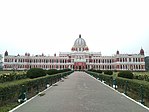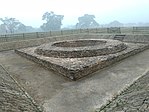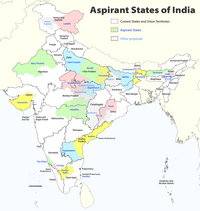Cooch Behar district
Cooch Behar district | |
|---|---|
|
Clockwise from top-left: Cooch Behar Palace, Gadadhar river nearTufanganj,Mount of Rajpat inGosanimari,Torsa river near Cooch Behar, Madan Mohan temple | |
 Location of Cooch Behar in West Bengal | |
| Country | |
| State | |
| Division | Jalpaiguri |
| Headquarters | Cooch Behar |
| Government | |
| •Lok Sabha constituencies | Cooch Behar |
| •Vidhan Sabha constituencies | Mathabhanga,Cooch Behar Uttar,Cooch Behar Dakshin,Sitalkuchi,Sitai,Dinhata,Natabari,Tufanganj |
| Area | |
| • Total | 3,387 km2(1,308 sq mi) |
| Population (2011) | |
| • Total | 2,819,086 |
| • Density | 830/km2(2,200/sq mi) |
| •Urban | 10.27% |
| Demographics | |
| •Literacy | 74.78% (2011) |
| • Sex ratio | 942 (2011) |
| Time zone | UTC+05:30(IST) |
| Vehicle registration | WB-64 |
| Major highways | NH 17 |
| Average annual precipitation | 3201 mm |
| Website | coochbehar |
Cooch Behar district(pronounced[ˈkuːtʃbiˈɦaːr]) is a district of the Indian state ofWest Bengal.
Formerly part of theKamarupa kingdom,the area became the heart of theKamata Kingdomin the 12th century. During theBritish Raj,the district was known asCooch Behar stateruled by theKoch dynastyuntil 1949, when it became part of India.
The district consists of the flat plains ofNorth Bengaland has several rivers: the most notable being theTeesta,JaldhakaandTorsa.The district has the highest proportion ofScheduled Castesin the country, where they form a majority.[1]
Etymology
[edit]The nameCooch Beharis derived from two words—Cooch,a corrupted form of the wordKoch,the name of theKochtribes, and the wordbeharis derived fromviharameaningland,Koch Behar meansland of the Koches.[2][3]
History
[edit]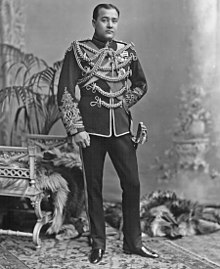
Early period
[edit]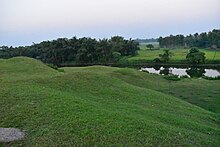
Cooch Behar formed part of theKamarupa Kingdomof Assam from the 4th to the 12th centuries. In the 12th century, the area became a part of theKamata Kingdom,first ruled by theKhen dynastyfrom their capital at Kamatapur. The Khens were an indigenous tribe, and they ruled till about 1498CE,when they fell toAlauddin Hussain Shah,the independent Pathan Sultan ofGour.The new invaders fought with the localBhuyan chieftainsand theAhomkingSuhungmungand lost control of the region. During this time, the Koch tribe became very powerful and proclaimed itselfKamateshwar(Lord of Kamata) and established the Koch dynasty.
The first important Koch ruler wasBiswa Singha,who came to power in 1515.[4]Under his son,Nara Narayan,the Kamata Kingdom reached its zenith.[5]Nara Narayan's younger brother, Shukladhwaj (Chilarai), was a noted military general who undertook expeditions to expand the kingdom. He became governor of its eastern portion.
After Chilarai's death, his son Raghudev became governor of this portion. Since Nara Narayan did not have a son, Raghudev was seen as the heir apparent. However, a late child of Nara Narayan removed Raghudev's claim to the throne. To placate him, Nara Narayan had to anoint Raghudev as a vassal chief of the portion of the kingdom east of theSankosh river.This area came to be known asKoch Hajo.After the death of Nara Narayan in 1584, Raghudev declared independence. The kingdom ruled by the son of Nara Narayan,Lakshmi Narayan,came to be known as Cooch Behar. The division of the Kamata Kingdom into Koch Behar and Koch Hajo was permanent. Koch Behar aligned itself with theMughal Empireand finally joined the India as a part of the West Bengal, whereas remnants of the Koch Hajo rulers aligned themselves with the Ahom kingdom and the region became a part ofAssam.
As the early capital of the Koch Kingdom, Cooch Behar's location was not static and became stable only when shifted to Cooch Behar town. Maharaja Rup Narayan, on the advice of an unknown saint, transferred the capital from Attharokotha toGuriahati(now called Cooch Behar town) on the banks of theTorsa riverbetween 1693 and 1714. The capital has always been in or near its present location since then.
In 1661 CE, Maharaja Pran Narayan planned to expand his kingdom. However,Mir Jumla,thesubedarofBengalunder the Mughal emperorAurangazeb,attacked Cooch Behar and conquered the territory, meeting almost no resistance.[6]The town of Cooch Behar was subsequently named Alamgirnagar.[7]Maharaja Pran Narayan regained his kingdom within a few days.
British Raj
[edit]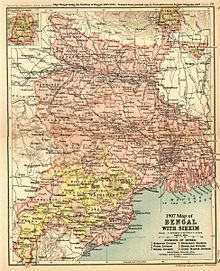
In 1772–1773, the king ofBhutanattacked and captured Cooch Behar. To expel the Bhutanese, the kingdom of Cooch Behar signed a defence treaty with theBritish East India Companyon 5 April 1773. After expelling the Bhutanese, Cooch Behar became a princely kingdom under the protection of British East India company.[8]
TheVictor Jubilee Palacewas based onBuckingham Palaceand built in 1887, during the reign of MaharajaNripendra Narayan.[7]In 1878, the maharaja married the daughter ofBrahmopreacherKeshab Chandra Sen.This union led to a renaissance in Cooch Behar state.[9]Maharaja Nripendra Narayan is known as the architect of modern Cooch Behar town.[10]
Post Independence
[edit]Under an agreement between the kings of Cooch Behar and the Indian Government at the end of British rule, MaharajaJagaddipendra Narayantransferred full authority, jurisdiction and power of the state to the DominionGovernment of India,effective 12 September 1949.[11]Eventually, Cooch Bihar became part of the state of West Bengal on 19 January 1950, with Cooch Behar town as its headquarters.[11]
Geography
[edit]
Cooch Behar is a district under theJalpaiguri Divisionof the state ofWest Bengal.Cooch Behar is located in the northeastern part of the state and bounded by the district ofJalpaiguriandAlipurduarin the north,DhubriandKokrajhardistrict ofAssamin the east and byBangladeshin the west as well as in the south. The district forms part of the HimalayanTeraiof West Bengal.
A geopolitical curiosity was that there were 92 Bangladeshiexclaves,with a total area of 47.7 km2in Cooch-Behar. Similarly, there were 106 Indian exclaves inside Bangladesh, with a total area of 69.5 km2.These were part of the high stake card or chess games centuries ago between two regional kings, the Raja of Cooch Behar and the Maharaja of Rangpur.[12]
Twenty-one of the Bangladeshi exclaves were within Indian exclaves, and three of the Indian exclaves were within Bangladeshi exclaves. The largest Indian exclave was Balapara Khagrabari which surrounded a Bangladeshi exclave, Upanchowki Bhajni, which itself surrounded an Indian exclave calledDahala Khagrabari,of less than one hectare (link to external map here[1]). But all this has ended in the historic India-Bangladesh land agreement. SeeIndo-Bangladesh enclaves.
Rivers and topography
[edit]Cooch Behar is a flat region with a slight southeastern slope along which the main rivers of the district flow. Most of the highland areas are in the Sitalkuchi region and most of the low-lying lands lie in Dinhata region.
The rivers in the district of Cooch Behar generally flow from northwest to southeast. Seven rivers that cut through the district are theTeesta,Jaldhaka,Torsha,Kaljani,Raidak,GadadharandGhargharia.
Flora and fauna
[edit]In 1976 Cooch Behar district became home to the Jaldapara Wildlife Sanctuary (nowJaldapara National Park), which has an area of 217 km2(83.8 sq mi).[13]It shares the park withAlipurduardistrict.[13]
Demographics
[edit]| Year | Pop. | ±% p.a. |
|---|---|---|
| 1901 | 565,116 | — |
| 1911 | 591,012 | +0.45% |
| 1921 | 590,599 | −0.01% |
| 1931 | 589,053 | −0.03% |
| 1941 | 638,703 | +0.81% |
| 1951 | 668,949 | +0.46% |
| 1961 | 1,019,806 | +4.31% |
| 1971 | 1,414,183 | +3.32% |
| 1981 | 1,771,643 | +2.28% |
| 1991 | 2,171,145 | +2.05% |
| 2001 | 2,479,155 | +1.34% |
| 2011 | 2,819,086 | +1.29% |
| source:[14] | ||
According to the2011 censusCooch Behar district has apopulationof 2,819,086,[15]roughly equal to the nation ofJamaica.[16]This gives it a ranking of 136th in India (out of a total of739).[15]The district has a population density of 833 inhabitants per square kilometre (2,160/sq mi).[15]Itspopulation growth rateover the decade 2001–2011 was 13.86%.[15]Koch Bihar has asex ratioof 942femalesfor every 1000 males,[15]and aliteracy rateof 75.49%.[15]10.27% of the population lives in urban areas. Scheduled Castes and Scheduled Tribes make up 1,414,336 (50.17%) and 18,125 (0.64%) of the population respectively. Cooch Behar is the only district in India where Scheduled Castes make up a majority of the population.[1]
Religion
[edit]| Religion | Population (1941)[18]: 104–105 | Percentage (1941) | Population (2011)[17] | Percentage (2011) |
|---|---|---|---|---|
| Hinduism |
394,948 | 61.63% | 2,087,766 | 74.05% |
| Islam |
242,684 | 37.87% | 720,033 | 25.54% |
| Others[a] | 3,210 | 0.5% | 11,287 | 0.41% |
| Total Population | 640,842 | 100% | 2,819,086 | 100% |
Hinduism is the majority religion. Islam is the minority religion, and is mainly rural. Muslims are a significant minority in Dinhata I (36.98%), Dinhata II (36.68%) and Sitalkuchi (35.31%) blocks.[17]
Language
[edit]Languages of Cooch Behar district (2011)[19]
At the time of the 2011 census, 94.79% of the population spokeBengali,1.31%Rajbongshiand 1.17%Hindias their first language. 2.01% of the population recorded their language as 'Others' under Bengali.[19]
Government and politics
[edit]Divisions
[edit]Sub-divisions
[edit]The district of Cooch Behar comprises five sub-divisions:
- Cooch Behar Sadar subdivision
- Dinhata subdivision
- Mathabhanga subdivision
- Tufanganj subdivision
- Mekhliganj subdivision
Assembly constituencies
[edit]As per order of the 2008Delimitation Commissionin respect of thedelimitation of constituenciesin the West Bengal, the district is divided into 9 assembly constituencies:[20]
Politics
[edit]| No. | Constituency | Name | Party | Remarks | |
|---|---|---|---|---|---|
| 1 | Mekliganj | Paresh Chandra Adhikary | All India Trinamool Congress | ||
| 2 | Mathabhanga | Sushil Barman | Bharatiya Janata Party | ||
| 3 | Cooch Behar Uttar | Sukumar Roy | Bharatiya Janata Party | ||
| 4 | Cooch Behar Dakshin | Nikhil Ranjan Dey | Bharatiya Janata Party | ||
| 5 | Sitalkuchi | Baren Chandra Barman | Bharatiya Janata Party | ||
| 6 | Sitai | Jagadish Chandra Barma Basunia | All India Trinamool Congress | ||
| 7 | Dinhata | Nisith Pramanik | Bharatiya Janta Party | Resigned[21] | |
| Udayan Guha[BYE] | All India Trinamool Congress | Won in 2021 bypoll | |||
| 8 | Natabari | Mihir Goswami | Bharatiya Janata Party | Deputy Leader of Opposition | |
| 9 | Tufanganj | Malati Rava Roy | Bharatiya Janata Party | ||
Mekliganj, Mathabhanga, Cooch Behar Uttar, Sitalkuchi and Sitai constituencies are reserved forScheduled Castes (SC)candidates. Mekhliganj constituency is part ofJalpaiguri (Lok Sabha constituency),which also contains six assembly segments fromJalpaiguri district.Mathabhanga, Cooch Behar Uttar, Cooch Behar Dakshin, Sitalkuchi, Sitai, Dinhata and Natabari constituencies form theCooch Behar (Lok Sabha constituency),which is reserved forScheduled Castes (SC).Tufanganj constituency is part ofAlipurduars (Lok Sabha constituency),which also contains six assembly segments fromAlipurduarand Jalpaiguri districts.
Education
[edit]Towns and villages
[edit]See also
[edit]- Indo-Bangladesh enclaves
- List of enclaves and exclaves
- List of West Bengal districts ranked by literacy rate
References
[edit]- ^ab"Census of India: Scheduled Castes & Scheduled Tribes Population".censusindia.gov.in.Retrieved5 February2021.
- ^Pal, Dr. Nripendra Nath (2000).Itikathai Cooch Behar (A brief history of Cooch Behar).Kolkata: Anima Prakashani. pp. 11–12.
- ^The name Cooch Behar is a compound of two words: Cooch and Behar. Cooch is a corrupted form of Coch or Koch, the name of an ethnic group of people inhabiting largely in vast tract of land to the north-east of Bengal. Behar or more properly Vihara denotes abode or sport. Cooch Behar means, therefore, the abode or land of the Koches. Ray, B..CENSUS 1961 WEST BENGAL.GOVERNMENT PRINTING, WEST BENGAL, 1961, p.20
- ^Nath, D. (1989),History of the Koch Kingdom, C. 1515-1615,Mittal Publications, pp. 5–6,ISBN8170991099
- ^"Royal History of Cooch Behar".Retrieved22 October2006.
- ^Pal, Dr. Nripendra Nath (2000).Itikathai Cooch Behar (A brief history of Cooch Behar).Kolkata: Anima Prakashani. p. 68.
- ^abBhattacharyya, PK (2012)."Kamata-Koch Behar".InIslam, Sirajul;Jamal, Ahmed A. (eds.).Banglapedia: National Encyclopedia of Bangladesh(Second ed.).Asiatic Society of Bangladesh.
- ^Pal, Dr. Nripendra Nath (2000).Itikathai Cooch Behar (A brief history of Cooch Behar).Kolkata: Anima Prakashani. p. 73.
- ^Pal, Dr. Nripendra Nath (2000).Itikathai Cooch Behar (A brief history of Cooch Behar).Kolkata: Anima Prakashani. p. 75.
- ^"Royal History of Cooch Behar 5".Retrieved22 October2006.
- ^ab"Brief Royal History of Cooch Behar 5".Archived fromthe originalon 24 July 2011.Retrieved22 October2006.
- ^"A Great Divide".Time.5 February 2009. Archived fromthe originalon 19 April 2011.
- ^abIndian Ministry of Forests and Environment."Protected areas: Sikkim".Archived fromthe originalon 23 August 2011.Retrieved25 September2011.
- ^Decadal Variation In Population Since 1901
- ^abcdef"District Census Handbook: Cooch Behar"(PDF).censusindia.gov.in.Registrar General and Census Commissioner of India.2011.
- ^US Directorate of Intelligence."Country Comparison:Population".Archived fromthe originalon 13 June 2007.Retrieved1 October2011.
Jamaica 2,868,380 July 2011 est
- ^abc"Table C-01 Population by Religion: West Bengal".censusindia.gov.in.Registrar General and Census Commissioner of India.2011.
- ^"CENSUS OF INDIA, 1941 VOLUME VI BENGAL PROVINCE"(PDF).Retrieved13 August2022.
- ^ab"Table C-16 Population by Mother Tongue: West Bengal".censusindia.gov.in.Registrar General and Census Commissioner of India.
- ^"Press Note, Delimitation Commission"(PDF).Assembly Constituencies in West Bengal.Delimitation Commission.Retrieved16 November2008.
- ^"Two West Bengal BJP MPs resign as MLAs after directive from party leadership".The New Indian Express.Retrieved8 April2022.
- ^IncludingJainism,Buddhism,Christianity,Zoroastrianism,Judaism,Ad-Dharmis,or not stated
Further reading
[edit]- Moore, Lucy (2004)Maharanis: The Extraordinary Tale Of Four Indian Queens And Their Journey From Purdah To Parliament,Penguin,ISBN0-670-03368-5

